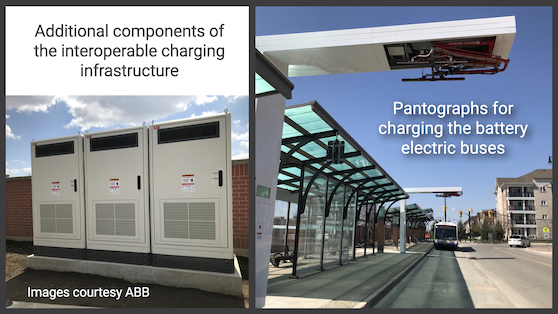
News
Interoperable battery electric buses? Brampton now has the world’s largest fleet
May 4, 2021
By
Anthony Capkun

May 4, 2021 – Brampton Transit in Ontario has the distinction of deploying the world’s largest fleet of interoperable and standardized battery electric buses (BEBs).
Brampton joins TransLink (Vancouver) and York Region Transit (Ontario) in this global-first, multi-city deployment of fully interoperable buses and charging systems in partnership with Nova Bus, New Flyer Industries, ABB Inc., Siemens Canada, and Newmarket-Tay Power Distribution Ltd.
“Supplying ABB’s charging solutions is part of our commitment in promoting sustainable mobility, and reinforces our strong contribution toward a low-carbon society,” said John Ieraci, E-mobility, ABB Canada.

Brampton’s deployment differs from other deployments where buses can only charge at designated charging depots. Brampton’s depot and on-road charging options allow for an increase in daily travel ranges on the electric buses.
The eight BEBs from Nova Bus and New Flyer in Brampton Transit’s fleet recharge completely in less than 10 minutes using four 450-kW overhead pantograph stations provided by ABB Inc. and Siemens Canada Ltd.
Nova Bus says its two 40-ft fully electric LFSe vehicles in the Brampton fleet boast an electric motor system powered by an integrated battery system, and charge in less than 6 minutes.
The deployment is part of the Pan-Canadian Electric Bus Demonstration and Integration Trial, which was launched in 2017 and is spearheaded by the Canadian Urban Transit Research & Innovation Consortium (CUTRIC).
The initiative is the first in the world where vehicles and chargers from different manufacturers can be used in fully interoperable form, meaning they can plug into one another’s charging infrastructure to gain a charge.
“Brampton’s world-leading deployment, which is being supported by five of CUTRIC’s Member companies, makes Canada a global hotbed of electric bus innovation,” said CUTRIC president & CEO, Josipa Petrunić.
WANT TO LEARN more about the Canadian Urban Transit Research & Innovation Consortium? Watch our discussion below with CUTRIC’s president & CEO, Dr. Josipa Petrunić.
Having achieved its initial goal of deploying 18 BEBs and seven chargers in Vancouver, York Region (Ontario) and Brampton, the trial is expanding to include hundreds of BEBs across seven cities as part of a national joint procurement initiative, says CUTRIC, “using an innovative funding and financing solution from the Infrastructure Bank of Canada”.
According to Catherine McKenna, federal Minister of Infrastructure & Communities, Ottawa is committed to adding 5000 zero-emission buses over five years.
All three transit agencies involved in the trial to-date have agreed to collect real-time BEB and charger data, and share those data sets with each other to support evidence-based electrification procurements in the immediate future.
CUTRIC, meantime, is currently collecting data from all operational vehicles and chargers to support empirical analysis and interoperability testing, and to build a Canadian E-Bus Big Data Trust for municipalities across the country.
“The growth and progress of the Pan-Canadian Electric Bus Demonstration and Integration Trial is shifting the entire zero-emission transit industry toward interoperability and standardization which, in turn, will help ensure that transit agencies and all levels of government benefit from a competitive marketplace,” Petrunić said. “This is good news for taxpayers, and great news for transit riders.”
Print this page